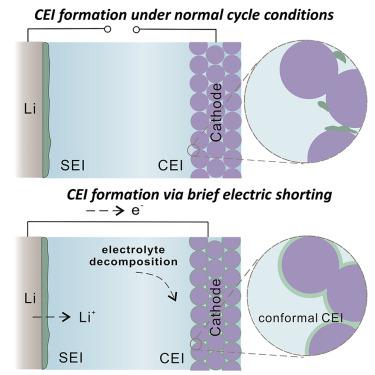Matter ( IF 17.3 ) Pub Date : 2020-11-09 , DOI: 10.1016/j.matt.2020.10.021 Zewen Zhang , Jinlong Yang , William Huang , Hansen Wang , Weijiang Zhou , Yanbin Li , Yuzhang Li , Jinwei Xu , Wenxiao Huang , Wah Chiu , Yi Cui

|
Cathode electrolyte interphase (CEI), the intimate coating layer formed on the positive electrode, has been thought to be critical. However, many aspects of CEI remain unclear. This originates from the lack of effective tools to characterize structural and chemical properties of these sensitive interphases at nanoscale. Here, we develop a protocol to preserve the native state and directly visualize the interface on the positive electrode using cryogenic electron microscopy. We find that under normal operation conditions, there does not exist an intimate coating layer at the single-particle level in carbonate-based electrolyte. However, upon brief external electrical shorting, a solid-electrolyte interphase, which usually forms on anodes, could form on cathodes and be electrochemically converted into a stable, conformal CEI in situ. The conformal CEI helps improve Coulombic efficiency and overall capacity retention of the battery. This generates a different perspective of CEI in commercial carbonate-based electrolytes than previously understood.
中文翻译:

低温电子显微镜显示锂电池中的阴极-电解质中间相
阴极电解质相间(CEI)是在正极上形成的均匀涂层,被认为是至关重要的。但是,CEI的许多方面仍不清楚。这是由于缺乏有效的工具来表征这些敏感的中间相的结构和化学性质。在这里,我们开发了一种协议来保留原始状态,并使用低温电子显微镜直接可视化正极上的界面。我们发现,在正常操作条件下,碳酸盐基电解质中不存在单颗粒水平的紧密涂层。但是,短暂的外部电短路后,通常在阳极上形成的固体电解质界面相可能会在阴极上形成,并被电化学转化为稳定的共形CEI原位。保形CEI有助于提高库仑效率和电池的整体容量保持率。与以前的理解相比,这在商业碳酸盐基电解质中产生了CEI的不同观点。











































 京公网安备 11010802027423号
京公网安备 11010802027423号